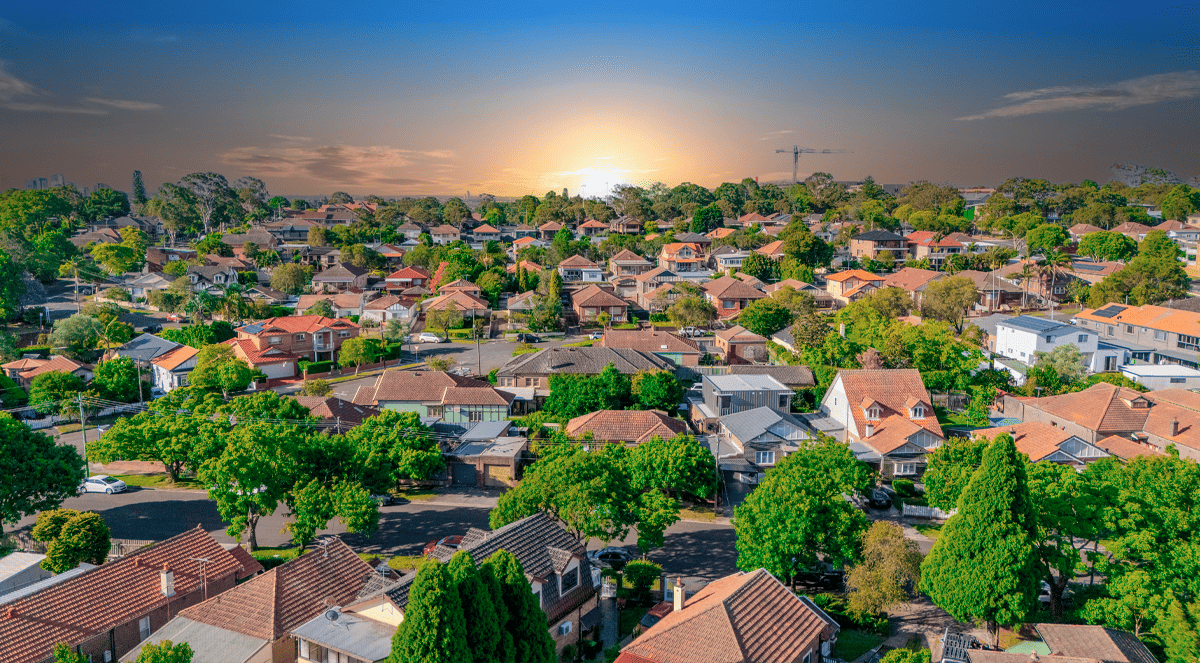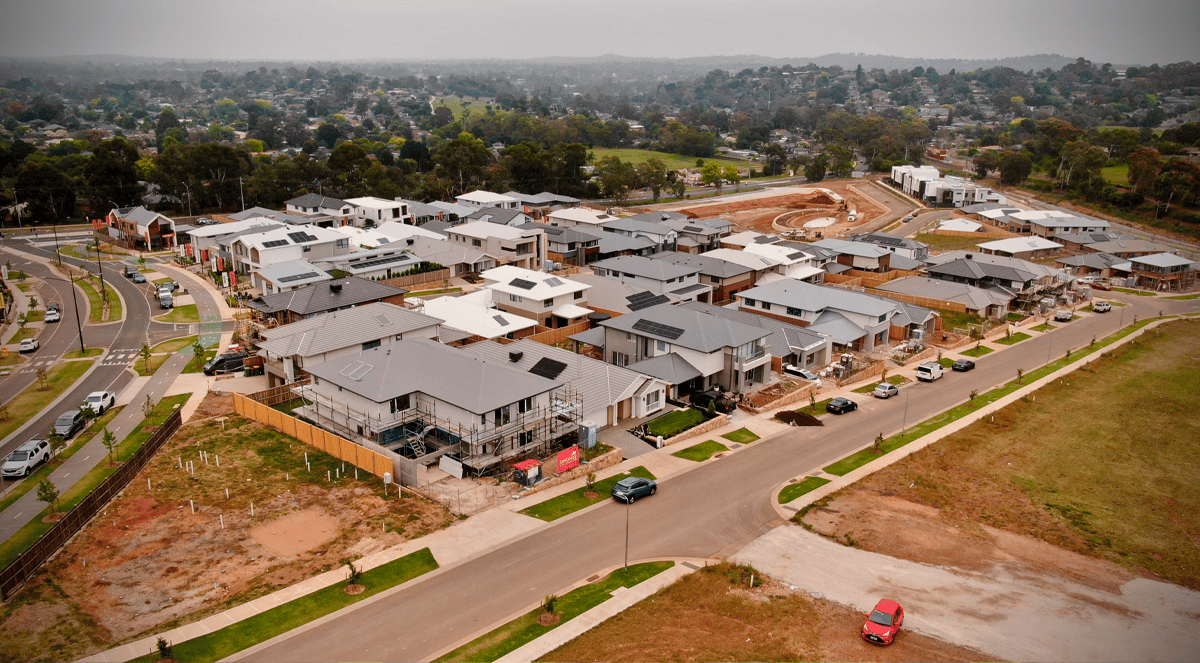Features > Property News & Insights > Market updates
Sydney & Melbourne to lead home price growth: Domain
.png)
KEY POINTS
- Sydney house prices are set to rise 7% to $1.83M and Melbourne 6% to $1.11M by mid-2026, predicts Domain
- House prices across capital cities will grow 6% and units 5%, driven by lower interest rates, strong demand, limited supply, and first-home buyer incentives
- Brisbane, Adelaide, and Perth will see 4–5% growth as affordability tightens and past surges begin to moderate, while Canberra stays stable but below its peak
Australia’s housing market is gearing up for another year of growth, with the country's two biggest real estate markets - Sydney and Melbourne - set to lead the way.
Domain Group’s latest home price forecast report says prices are expected to reach record levels in Sydney, Brisbane, and Adelaide by the end of the 2025-26 financial year.
In Melbourne, Domain says house prices are also forecast to reach record highs, while unit prices are projected to partially recover, remaining 3% below their historical peak.
The details
Domain says it expects house prices in Australia’s capital cities to lift on average by 6% over the next 12 months, with unit prices growing slightly slower at 5%.
Much of the price growth will come from Australia’s two largest real estate markets - Sydney and Melbourne.
“Lower interest rates, cheaper borrowing, and targeted support for first-home buyers will keep prices rising, especially in Sydney and Melbourne, which are most sensitive to rate changes,” says Dr Nicola Powell, Domain’s Chief of Research and Economics.
Sydney
By the end of June next year, Domain predicts Sydney’s median house price will reach an eye-watering $1.83 million, marking an increase of $112,000 or 7% on the current figure.
Dr Powell says that the expected 12-month uplift in value for a median house would outpace the median annual wage of $103,000 for a full-time employee.
Dr Powell says the effect of lower borrowing costs from the Reserve Bank of Australia’s last two interest rate cuts is expected to heavily contribute towards Sydney’s price growth in the short term and see it have the fastest housing price growth of any of the mainland capitals.
“This reflects the higher levels of debt and willingness to take on leverage, so shifts in borrowing costs have a larger impact on the market in the near term,” Dr Powell says.
Unit prices in Sydney are also set to accelerate over the next year, with the city’s median price expected to reach $889,000, a 6% or $53,000 boost, by the end of June next year.
Dr Powell says Sydney’s low unemployment rate, rising incomes and relatively low new home approvals were also expected to push prices higher over the year.
Melbourne
Domain predicts house price growth in Melbourne will accelerate over the second half of 2025 and reach a record median of $1.11 million by the end of June next year.
Dr Powell says the expected growth of 6% or $66,000 in Melbourne would mark a full recovery from the city’s previous downturn in values during the years 2022–24.
The Domain Home Price Forecast Report also says that Melbourne’s unit prices are anticipated to rise due to lower interest rates and relative levels of affordability.
Nicola Powell says Melbourne’s median unit price is forecast to reach $584,000 by the end of 2025.
However, that’s still 3% below the Melbourne market’s 2021 unit price peak.
Sydney’s traditional price premium over Melbourne has blown out from 26% in 2019 to 63%, making the Victorian capital increasingly attractive to price-sensitive buyers.
But while Dr Powell says Melbourne’s affordability positions it for more growth, she says Victoria faces challenges.
“Higher taxes and a more limited capacity for infrastructure investment could make it (Victoria) less attractive than other states,” she says.
Other capitals
While price growth in the two largest capital cities is expected to accelerate, Domain’s Home Price Forecast Report predicts the recent frenetic pace of growth in Perth, Brisbane, and Adelaide will slow over the next 12 months.
Brisbane house prices are expected to grow 5% to a median of $1.09 million over the next year, while Adelaide’s median house price is expected to grow 4% to $1.05 million.
Domain is tipping Perth’s house prices to notch up 5% growth to $982,000 by the end of June 2026, which will position the city to join the million-dollar median house price club by the end of next year.
Canberra remains the outlier—steady growth, but still shy of peak values.
House prices are expected to recover into the lower $1 million range, with units about 15% below their recent highs.
The city’s low price-to-income ratio, compared to other capitals, might well attract price-sensitive buyers.
The outlook
Despite local differences across Australia’s capital cities, four shared trends underpin Domain’s housing outlook:
- Interest rates - The Reserve Bank of Australia has already cut the cash rate by 0.50% this year, with markets expecting another 0.80% cut by mid‑2026.
These rate reliefs bolster borrowing capacity—especially in debt-heavy cities like Sydney and Melbourne.
However, Domain’s Nicola Powell warns the upswing in price growth is expected to be more modest than in previous rate-cutting cycles.
“This reflects forecasts of smaller, more gradual rate reductions and ongoing affordability challenges, with housing costs continuing to take up a significant portion of household income in most capital cities.” - Population momentum - While migration is easing, demand remains strong.
Interestingly, rising rental stress is encouraging the formation of larger households and boosting demand for affordable dwellings like units. - Constrained supply - While new housing projects are slowly ramping up, pipelines still fall way short of the federal Housing Accord target of 240,000 new homes per year.
Labour shortages, planning delays, and higher construction costs continue to slow completions. - Policy support and incomes - A growing suite of first-home buyer incentives, such as initiatives to remove Lenders’ Mortgage Insurance and expanding shared-equity schemes, are likely to funnel more buyers into more affordable segments of the market.
Combined with real income growth from slowing inflation and stronger wages, this will help underpin housing demand.
Stay Up to Date
with the Latest Australian Property News, Insights & Education.




.png?width=292&height=292&name=Copy%20Link%20(1).png)
 SIGN UP FOR FREE NEWSLETTER
SIGN UP FOR FREE NEWSLETTER





.jpg?width=1920&height=1080&name=Warning%2c%20You%20Might%20Be%20Facing%20Higher%20Taxes%20Soon%20(1).jpg)





.png?width=1920&height=1080&name=Rate%20Drops%20Signal%20BIGGEST%20Property%20Boom%20in%20DECADES%20(1).png)

.jpg?width=1920&height=1080&name=Labor%20vs%20Liberal%20These%20Housing%20Policies%20Could%20Change%20the%20Property%20Market%20Forever%20(1).jpg)
.jpg?width=1920&height=1080&name=QLD%20Slashes%20Stamp%20Duty%20Big%20News%20for%20Investors%20%26%20Home%20Buyers%20(1).jpg)
.jpg?width=1920&height=1080&name=Trump%20Just%20Slapped%20Tariffs%20%E2%80%93%20Here%E2%80%99s%20What%20It%20Means%20for%20Australia%20(1).jpg)
.jpg?width=1920&height=1080&name=Federal%20Budget%202025%20More%20Debt%2c%20No%20Housing%20%E2%80%93%20Here%E2%80%99s%20What%20You%20Need%20to%20Know%20(1).jpg)
.jpg?width=1920&height=1080&name=Australias%20Housing%20Crisis%20is%20about%20to%20get%20MUCH%20Worse%20(New%20Data%20Warns).jpg)
%20(1).jpg?width=1920&height=1080&name=Australias%20RENTAL%20CRISIS%20Hits%20ROCK%20BOTTOM!%20(2025%20Update)%20(1).jpg)
%20(1).png?width=1920&height=1080&name=Is%20Adelaide%20Still%20a%20Good%20Property%20Investment%20(2025%20UPDATE)%20(1).png)
.jpg?width=1920&height=1080&name=RBA%20Shocks%20with%20Rate%20Cuts!%20What%E2%80%99s%20Next%20for%20Property%20Investors%20(1).jpg)
%20(1).jpg?width=1920&height=1080&name=I%20Predict%20The%20Feb%20Rate%20Cut%20(My%20Price%20Growth%20Prediction)%20(1).jpg)
.png?width=1920&height=1080&name=Why%20Property%20Prices%20Will%20Rise%20in%202025%20Market%20Predictions%20(1).png)
.jpg?width=1920&height=1080&name=Why%20Investors%20Are%20Choosing%20Apartments%20Over%20Houses%202%20(1).jpg)
.jpg?width=1920&height=1080&name=Why%20Rate%20Cuts%20Will%20Trigger%20A%20Property%20Boom%20(1).jpg)
.jpg?width=1920&height=1080&name=Retire%20On%202Million%20With%20One%20Property%20(Using%20SMSF).jpg)
.jpg?width=1920&height=1080&name=4%20Reasons%20Why%20You%20Should%20Invest%20in%20Melbourne%20Now%20(1).jpg)
%20(1).jpg?width=1920&height=1080&name=Old%20Property%20vs%20New%20Property%20(Facts%20and%20Figures%20Revealed)%20(1).jpg)
%20(1).jpg?width=1920&height=1080&name=Will%20The%20New%20QLD%20Govt%20Create%20a%20Property%20Boom%20or%20Bust%20(My%20Prediction)%20(1).jpg)
%20Scott%20Kuru%20(1).jpg?width=1920&height=1080&name=Inflation%20Hits%20Three-Year%20Low%20(Will%20RBA%20Cut%20Rates%20Soon)%20Scott%20Kuru%20(1).jpg)
.jpg?width=1920&height=1080&name=How%20to%20Buy%20Investment%20Property%20Through%20SMSF_%20The%20Ultimate%20Guide%20(1).jpg)
.jpg?width=1920&height=1080&name=Victoria%20Slashes%20Stamp%20Duty%20Melbourne%20Set%20to%20Boom%20Scott%20Kuru%20(1).jpg)
.png?width=1571&height=861&name=Are%20Foreign%20Buyers%20Really%20Driving%20Up%20Australian%20Property%20Prices%20(1).png)
.jpg?width=1920&height=1080&name=The%20Single%20Factor%20That%20Predicts%20Property%20Growth%20Regions%20(1).jpg)
%20Scott%20Kuru%20(1).jpg?width=1920&height=1080&name=My%20Prediction%20On%20Rates%20%26%20Negative%20Gearing%20(Market%20Crash)%20Scott%20Kuru%20(1).jpg)

-1.png?width=1920&height=1080&name=Major%20Banks%20Cut%20Rates%20Will%20RBA%20Follow%20Suit%20(Sept%20Rate%20Update)-1.png)
%20Scott%20Kuru-1.png?width=1920&height=1080&name=Rate%20Cut%20Coming%20What%20New%20Zealands%20Move%20Means%20for%20Australia%20(Sept%20Prediction)%20Scott%20Kuru-1.png)
%20(1).jpg?width=1920&height=1080&name=Buy%20when%20the%20interest%20rates%20are%20high!%20(Why%20you%20must%20buy%20now!)%20(1).jpg)
.jpg?width=1920&height=1080&name=Carms_Revised%20Taxes%20Due%20Aug%209%20YT%20Thumbnail02%20(1).jpg)
.jpg?width=1920&height=1080&name=Carms_Too%20Little%20Too%20Late%20Aug%207%20YT%20Thumbnail01%20(1).jpg)









.jpg?width=1920&height=1080&name=Carms_Rate%20Drop%20In%20July%20Jun%2010%20YT%20Thumbnail02%20(1).jpg)
.jpg?width=1920&height=1080&name=Carms_Own%20a%20Property%20V6%20Jun%205_YT%20Thumbnail%20(1).jpg)









.png?width=1920&height=1080&name=Artboard%201%20(3).png)






.jpg?width=1920&height=1080&name=YT%20thumbnail%20%20(1).jpg)

